June 06, 2011 – 08:28 am EDT
All was looking positive on Tuesday with the market posting some nice steady gains. However by Wednesdays close it was clear that the market was behaving in a manor we have not witnessed for some time. Come Friday, all of the major support levels we have been monitoring were lost and we moved mostly to cash.
Trading is all about having a plan and sticking to it. Sometimes that requires intestinal fortitude and sometimes it requires admitting when you are wrong and taking a loss. The important thing is that one has a plan and knows what they are going to do in every situation. We are involved in a business of probabilities and as George Soros said “It’s not whether you’re right or wrong that’s important, but how much money you make when you’re right and how much you lose when you’re wrong.”
Lets take a closer look…
.
ETF % Change Comparison
.

The Transports (IYT), Small Caps (IWM) and Semis were all hit hard over the last week with SMH now further from its peak that any of the other influential ETFs. This is not a good look and the recent declines need to be taken seriously.
Learn more – ETF % Change Comparison
.
![]()
.
A Look at the Charts
.
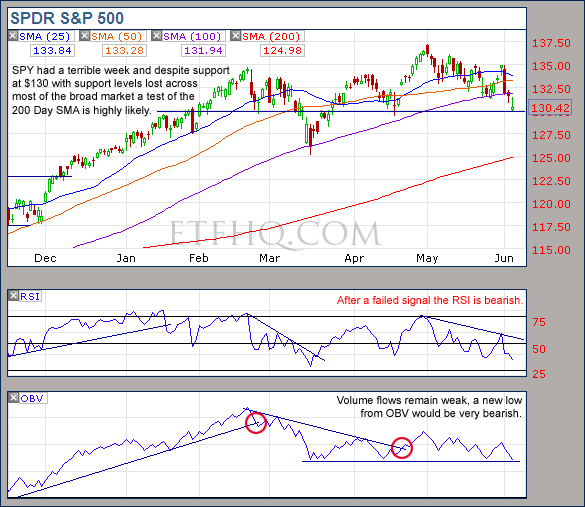
A loss of $130 and a new low from OBV would be exceedingly bearish.
.
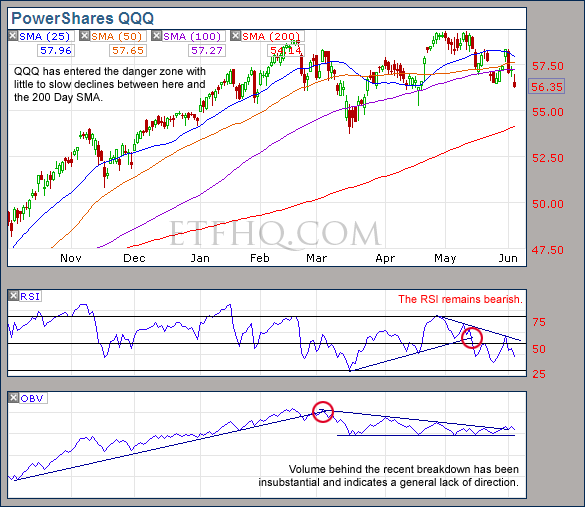
QQQ is in the danger zone but volume indicates a lack of direction.
.
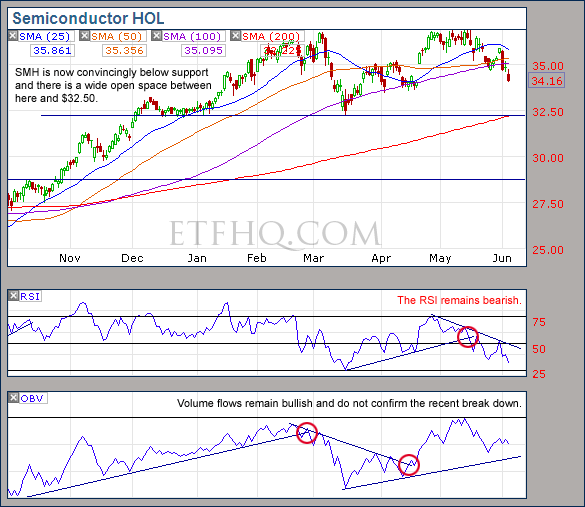
The breakdown by SMH is a major blow to this market but volume does not yet confirm the move.
.
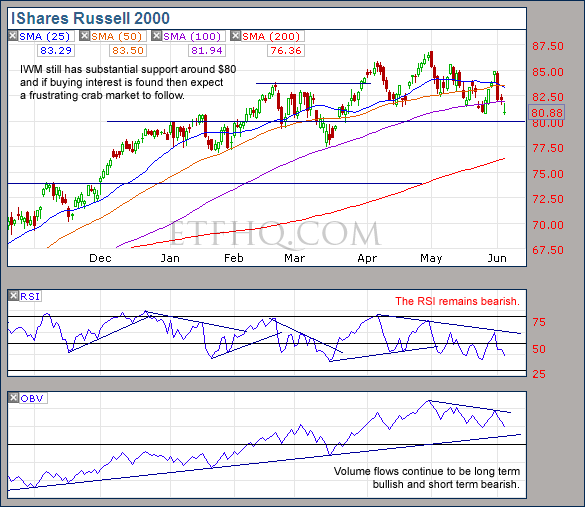
Keep an eye out for buying interest around $80.
.

The Transports have been offering great support to this market until recently.
.
![]()
.
OM3 Weekly Indicator
.

The OM3 Indicator is bearish across the board.
Learn more – The OM3 Indicator
.
![]()
.
TransDow & NasDow
.

TransDow – The Dow has become dominant over the Transports and caused a closure of the DJT position for a loss of 5.34% over 35 days.
NasDow – The NASDAQ remains dominant over the Dow and the position in the NASDAQ remains open with a current loss if 3.23%
.
What the TransDow Readings tell us:
The TransDow measures dominance between the DJ Transportation Index (DJTI) and the Dow Jones Industrial Average (DJIA). In a strong market the more economically sensitive Transportation Index should be dominant over the DJIA.
Historically the DJTI has been dominant over the Dow 45% of the time. The annualized rate of return from the DJTI during this period was 18.47% with the biggest loss for one trade sitting at -13.27%. The annualized return from the DJIA during the periods it was dominant over the DJTI was just 4.06% and the biggest loss for one trade was -16.13%. A 4% stop-loss is applied to all trades adjusting positions only at the end of the week.
What the NasDow Readings tell us:
The NasDow measures dominance between the NASDAQ and the DJIA. Using the same theory behind the Trans Dow; in a strong market the more economically sensitive NASDAQ should be dominant over the DJIA.
Historically the NASDAQ has been dominant over the DJIA 44% of the time. Taking only the trades when the NASDAQ is above its 40 week moving average the annualized rate of return was 25.47% with the biggest loss for one trade sitting at –8.59%. The annualized rate on the DJIA during the periods it was dominant over the NASDAQ is just 8.88% and the biggest loss for one trade was –12.28%. A 8% stop-loss is applied to all trades adjusting positions only at the end of the week.
.
![]()
.
LTMF 80 & Liquid Q
.
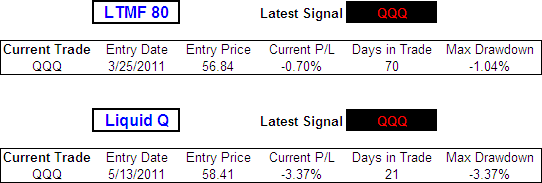
Both LTMF 80 and Liquid Q continue to hold open positions in QQQ each showing a small loss.
.
Historical Stats:
.

.
How The LTMF 80 Works
LTMF stands for Long Term Market Forecaster. It reads volume flows relative to price action and looks for out performance of volume measured on a percentage basis over the prior 12 months. During a sustained rally the readings will reach high levels (near 100%) making it imposable for the volume reading to always outperform price so any reading above 80% will maintain the buy signal. This system has outperformed the market over the last 10 years but performance has been damaged by some nasty losses. It only produces buy signals and only for QQQ.
How Liquid Q Works
Liquid Q completely ignores price action and instead measures the relative flow of money between a selection of economically sensitive and comparatively stable ares of the market. It looks for times when the smart money is confident and and can be seen by through volume investing heavily is more risky areas due to an expectation of expansion. This system has outperformed the market over the last 10 years and remained in cash through most of the major declines. It only produces buy signals and only for QQQ. We will provide more performance details on the web site for these systems soon.
.
![]()
.
Summary
We have moved mostly to cash in response to a broad based loss of support and unhealthy market behavior. Volume flows however are not convincingly bearish and this may lead to a frustrating sideways grind. Make no mistake though, the technical damage that has been done makes it extremely unlikely that we will see a successful attempt at new highs before a further correction.
Any disputes, questions, queries, comments or theories are most welcome in the comments section below.
.
Cheers
Derry
And the Team @ ETF HQ
“Equipping you to win on Wall St so that you can reach your financial goals.”
.
![]()
.
Quote of the Day
“Money is multiplied in practical value depending on the number of W’s you control in your life: what you do, when you do it, where you do it, and with whom you do it. I call this the freedom multiplier.” – Timothy Ferriss
.
.
Dear Derry,
Good, insightful call…… I’m betting that the May 2nd high will go down in history along with the highs of 2007, 2000, 1990, 1987 and 1929……….. My past experience and my gut are telling me that 2007 was 1929 and 2011 will go down as 1930 when the real blood letting occurred…. In my opinion, the government intervention of QE-1 and 2 have only delayed the inevitable , caused another fraudulent rally and in the end, made the coming crash even worse….. And, yes, I also stepped aside days before 1987 and 1990 and shortly (within weeks) after the tops of 2000 and 2007……. In my opinion, we are going to make more money in inverse funds for equities, precious metals and real estate for many years to come……… In the future, I believe many will begin to refer to the removal of the Glass-Steagall Act in 1999 as the failure of good Congressional judgement which led to the Great Crash which was forewarned in 2000 and then began in 2007….Mike Scott
All good points yet again Mike. I will expect much more prolific volume out of SMH and IWM before any crash occurs. These events never come without warning and the risk levels (in my eyes) are not that high just yet. Would love another year like 2008, the money was too easy!
Derry